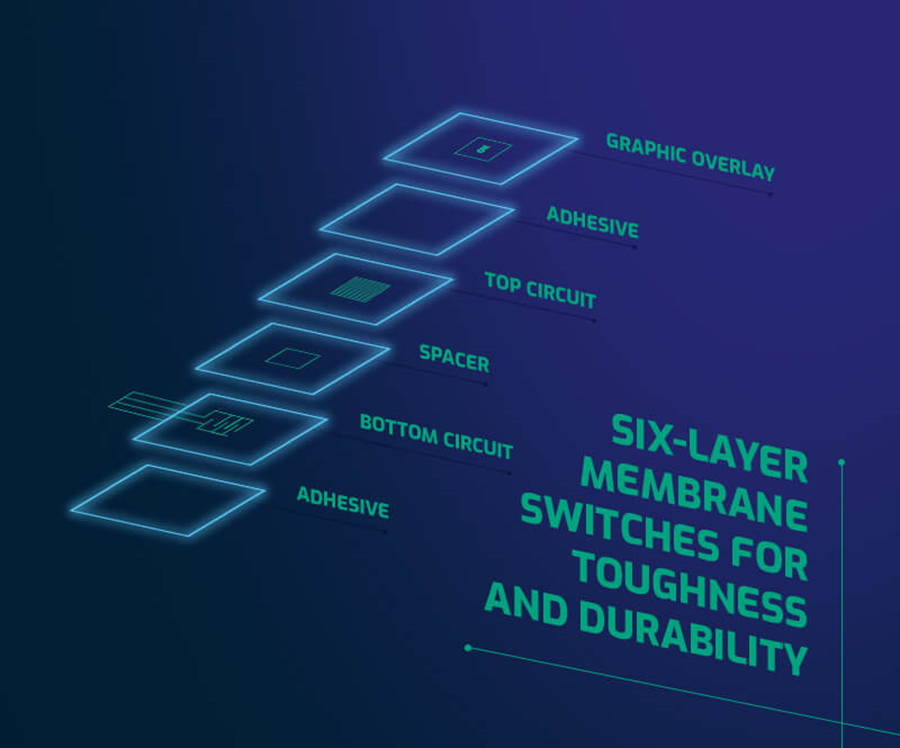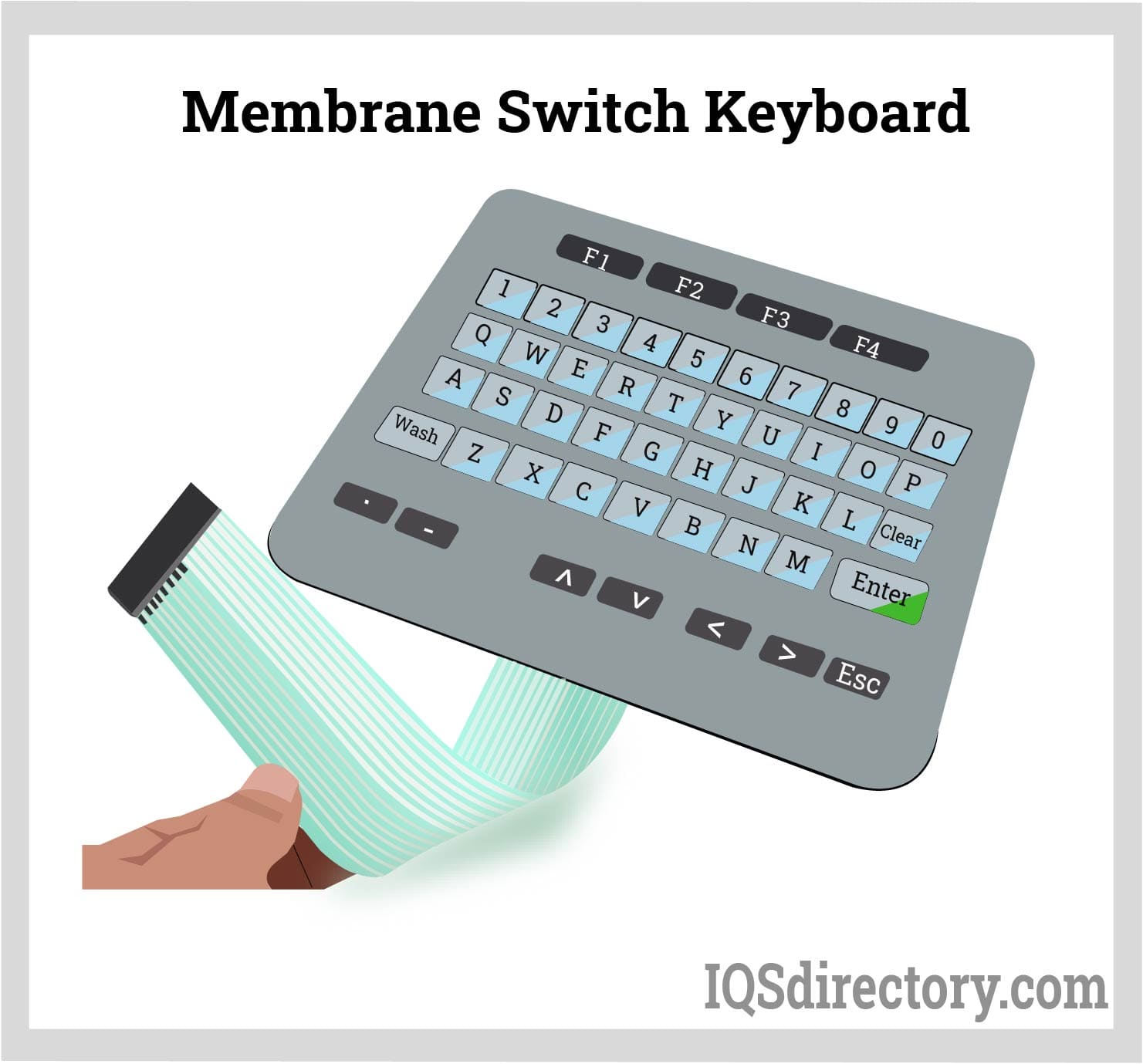The Production Process Behind Membrane Layer Change: What You Required to Know
The manufacturing procedure behind membrane switches over combines cautious layout, material option, and quality assurance. It starts with comprehending the details of membrane button design and proceeds through different phases, including product choices and printing methods. Each stage plays a crucial role in making certain functionality and toughness. The intricacies of layer construction and the extensive screening criteria may reveal insights that are not quickly apparent. What lies beyond these fundamental components?
Understanding Membrane Layer Switch Over Layout
Although membrane switches may appear straightforward at very first glance, their design includes complex factors to consider that assure functionality and sturdiness. The style process begins with a detailed understanding of customer needs, consisting of the user interface's desired application and ecological aspects. Comfort designs is a vital component, as the format needs to assist in simplicity of use while guaranteeing that tactile feedback fulfills customer expectations.Moreover, the layering of parts, such as visuals overlays, sticky layers, and conductive traces, should be precisely crafted. membrane switch. This split setup not only influences the button's responsiveness however likewise impacts its longevity. Focus is offered to the securing techniques used to shield versus wetness and dust, which can jeopardize performance. In addition, style considerations encompass visual appeals, where color pattern and visual quality improve user experience. Inevitably, the style of membrane switches over balances capability, individual experience, and resilience, ensuring that they satisfy the demands of numerous applications efficiently
Products Utilized in Membrane Layer Change Production
When choosing products for membrane button manufacturing, it is necessary to consider both efficiency and sturdiness. The primary materials consist of polyester and polycarbonate films, which supply flexibility and stamina. These films are commonly coated with sticky to assure proper bonding to substratums. Conductive inks, usually composed of silver or carbon, are vital for developing electrical links within the button, allowing for trusted operation.Additionally, a protective layer, such as a difficult layer, is frequently applied to enhance scratch resistance and durability. The choice of backing product, such as acrylic or foam, can significantly affect the switch's responsive feeling and total customer experience. Moreover, numerous ecological variables, including temperature and moisture, need to guide material choice to ensure peak efficiency in details applications. Inevitably, the appropriate mix of products adds to the membrane layer button's functionality and lifespan, making informed choices vital for makers.
The Printing Refine: Creating Video and Text
The printing process in membrane switch manufacturing plays a significant role in producing top quality graphics and text. Various graphic design strategies are used to assure aesthetic charm and performance, while cautious ink option methods are important for sturdiness and performance. Understanding these elements is basic for attaining finest lead to membrane button layout.
Graphic Design Techniques
Graphic layout methods play a vital role in the printing procedure of membrane buttons, as they define how graphics and message will ultimately show up on the end product. Efficient visuals style involves the critical use formats, colors, and typefaces to improve readability and aesthetic charm. Developers frequently make use of vector graphics for scalability, guaranteeing that photos remain sharp at different dimensions. Furthermore, focus to contrast and positioning is essential, as it influences individual communication and aesthetic high quality. The unification of branding elements, such as logo designs, have to be handled with treatment to keep brand name honesty. In general, thoughtful visuals layout techniques contribute significantly to the capability and beauty of membrane buttons, influencing user experience and product performance.
Ink Choice Approaches
Selecting the suitable ink is necessary for attaining the wanted visual quality and sturdiness in membrane layer button manufacturing. Numerous ink kinds are utilized, including solvent-based, water-based, and UV-curable inks. Each type provides distinct qualities, such as adaptability, resistance, and attachment to ecological variables. Solvent-based inks are often preferred for their durability and vibrant shades, while water-based inks are extra eco pleasant yet might have restrictions in bond. UV-curable inks offer rapid healing and durable performance. Additionally, color matching strategies assure that the picked inks line up with style specifications. Ultimately, the selection of ink need to think about elements such as application method, substratum compatibility, and end-use needs to achieve premium results in membrane layer button graphics and text.
Layer Construction and Setting Up

Product Choice Refine
A mindful option of products is crucial in the production procedure of membrane layer buttons, as it straight affects performance and longevity. The key products made use of consist of polyester, polycarbonate, and different conductive inks. Polyester is commonly preferred for its exceptional resistance to chemicals and abrasion, making it appropriate for extreme atmospheres. Polycarbonate, on the other hand, offers exceptional clarity and impact resistance, which is advantageous for applications requiring presence and effectiveness. Conductive inks, commonly made up of silver or carbon, are crucial for producing dependable electrical paths. In addition, the option of adhesive products influences the general integrity of the button - membrane switch. Examining elements such as environmental exposure, responsive comments, and aesthetic needs guides manufacturers in picking the very best materials for their details applications
Layer Bond Techniques
Sticking layers in membrane button building and construction is an important procedure that ensures functionality and long life. Different adhesion methods are employed to safeguard optimal bonding in between layers, which normally include the usage of adhesives, heat, and stress. Pressure-sensitive adhesives (PSAs) are typically made use of for their simplicity of application and prompt bonding abilities. In addition, thermal bonding methods can be used, where heat is made use of to activate sticky residential or commercial properties, safeguarding a strong bond. The option of adhesion technique greatly depends on the products involved and the particular application needs of the membrane switch. Correct alignment and uniform application of adhesives Continue are necessary to avoid flaws, securing the switch runs properly throughout its intended life expectancy.
Top Quality Control Measures
Ensuring high quality control throughout the layer construction and assembly of membrane buttons is crucial for maintaining performance and dependability. This procedure commonly involves a number of important actions, consisting of comprehensive assessments at each phase of manufacturing. Suppliers make use of advanced testing methods, you can try here such as peel tests and adhesion assessments, to confirm the stability of layer bonds. Furthermore, visual assessments are carried out to determine any type of flaws in printing or product variances. Ecological problems, such as temperature and humidity, are thoroughly kept track of to ensure optimal treating and adhesion. Regular calibration of tools aids preserve exact manufacturing standards. By implementing these top quality control actions, makers can considerably decrease the risk of item failing, guaranteeing that the last membrane layer changes meet the called for specs and client assumptions.
Examining and Quality Assurance Measures

Developments in Membrane Switch Over Modern Technology
As advancements in modern technology remain to advance, membrane layer buttons are taking advantage of ingenious developments that enhance their capability and customer experience. One noteworthy advancement is the integration of capacitive touch innovation, which enables more responsive and user-friendly interface. This shift not only improves appearances yet also decreases mechanical wear and tear, extending the life-span of the switches.Additionally, innovations in visuals overlay products have actually resulted in improved durability and resistance to environmental variables such as moisture and UV light. These materials now use boosted quality and illumination, additional boosting the aesthetic appeal.Furthermore, the incorporation of wise modern technology is changing membrane changes right into interactive control panels, making it possible for connection with IoT tools. This connectivity fosters a seamless user experience, leading the means for applications in different industries, from health care to consumer electronic devices. Collectively, these innovations position membrane switches over as important components in modern tool layout.
Often Asked Concerns
Exactly how Lengthy Does the Membrane Layer Switch Over Manufacturing Process Take?
The period of the membrane layer switch production procedure can vary significantly. Aspects such as intricacy, products used, and production volume impact timelines, with regular manufacturing ranging from a couple of days to several weeks for completion.
What Are the Usual Applications for Membrane Layer Buttons?
Membrane switches are commonly made use of in different sectors, consisting of automobile controls, household home appliances, medical devices, and consumer electronics (membrane switch). Their flexibility and durability make them suitable for applications needing easy to use user interfaces and trusted performance in varied atmospheres
Can Membrane Changes Be Personalized for Specific Needs?

What Is the Life-span of a Normal Membrane Layer Change?
The lifespan of a common membrane layer switch differs, but normally, it varies from 1 to 5 million cycles. Aspects such as usage, atmosphere, and worldly high quality greatly affect toughness and total efficiency with time.

Are Membrane Layer Changes Ecologically Friendly?
The environmental kindness of membrane changes differs. Some products utilized may not be recyclable, while others can be eco-friendly. The general influence relies on manufacturing products and practices, demanding cautious consideration during choice and disposal. The production process behind membrane layer switches over combines mindful design, material option, and top quality control. It begins with recognizing the complexities of membrane button style and proceeds through numerous phases, consisting of material selections and printing strategies. When selecting products for membrane switch manufacturing, it is important to ponder both performance and sturdiness. A cautious option of materials is vital in the production procedure of membrane buttons, as it directly influences functionality and resilience. The selection of bond approach largely depends on the materials involved and the details application requirements of the membrane layer button.